lab book.
A GUIDE FOR INNOVATIVE MATERIALS
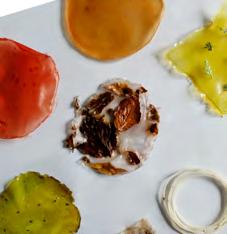 EDITED BY NICLA GUARINO
EDITED BY NICLA GUARINO
03 part growing
materials
overview.
GROWING MATERIALS
textiles and materials

easy to grow seeds




CATNIP
GERMINATION: 7-10 days
CHIA GERMINATION: 3-14 days

LAVENDER GERMINATION: 15-30 days



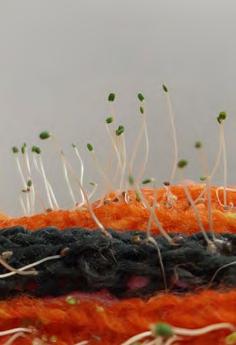
LEMON
GERMINATION: 7-9 days
SUNFLOWER GERMINATION: 10-14 days




3 2
COTTON PADS
COTTON YARN WOOL FELT
COTTON CANVAS
KNIT WOOL
PAPER TOWEL
AGAR SUBSTRATE
COTTON WOOL
Dutch Passion
Naturalmentefarma Mombrite
Graceandgrub
MEILENWEIT - Lana Grossa
Kew
Walmart
Lara Campos - beGrounded
results & tools.
GROWING MATERIALS

16
BEST
SEEDS:
CHIA SEEDS
results:
TRIALS TOTAL
main tools & ingredients
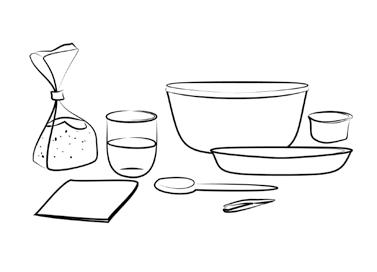
SEEDS
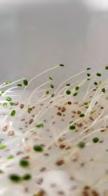

WATER & GLASSES
PLATES & CONTAINERS with LIDS
JARS
TEXTILE SAMPLES
SPOONS
TWEEZERS
5
7 part 03 GROWING MATERIALS 9 seeds structure 73 sunflower 11 lavender 17 lemon 23 catnip 41 chia
REFERENCE: Anatomy of Flowering Plants
The Seed by Toppr https://www.toppr.com/guides/biology/anatomy-offlowering-plants/the-seed/
Parts of a Seed and Their Functions by ScienceFacts. net https://www.sciencefacts.net/parts-of-a-seed.html
What is the Difference Between Cotyledons and True Leaves by Pediaa.com https://pediaa.com/what-is-the-difference-betweencotyledons-and-true-leaves/
seeds structure.
seed coat
It is the outer part of the seed, composed of an hard, thick and protective cover of the embryonic plant.
radicle
It is the primary root of the plant, that usually blooms out of the seed coat during germination.
seminal roots
They are all the secondary roots that push the way out of the seed. Their function is to provide external nutrients.
coleoptile
It is the covering region and protective sheath of the epicotyl.
cotyledons
They are the embryonic leaves, known also as seed leaves.
hypocotyl
It is the embryonic stem that pushes the cotyledons to the surface.
epicotyl
It is the tiny shoot of an embryo that gives rise to the stem and leaves
true or primary leaf
It is first foliage leaf of the flowering plants. They are thinner and softer than cotyledons.
9 8
Parts of an Emerging Corn Plant, K-STATE,KSU CROPS,KANSAS CORN 09/2017
Parts of an Emerging Corn Plant
Seed Coat Coleoptile
Radicle Hypocotyl Root
Epicotyl
First Leaf
Image provided by
General info
BOTANICAL NAME:
GERMINATION:
LIFE CYCLE:
PLANTING PERIOD:
HARVEST PERIOD:
WATERING FREQUENCY:
SUITABLE FOR POTS:
SEEDS SHAPE:
SEEDS COLOR:
SEEDS DIMENSIONS:
LIGHT REQUIREMENT:
TEMPERATURE REQUIREMENT:
HUMIDITY REQUIREMENT:
DISTANCE REQUIREMENT:
USE:
lavender.
Lavanda officinalis, Lavandula angustifolia

15-20 days
Perennial
April - may
June - september
1-2 times/week Yes
Oval Black
LENGTH: 2 mm THICKNESS: 1.5-2 mm
Full sun
10-30 °C
Not specified
SPACING: 30 cm DEPTH: 30 mm
Fragrance, ornamental, medicinal purposes
11 10
Klara Kulikova - Unsplash
trial n.1
Lifecycle
pads Lavender seeds Water Plate or container Plastic wrap or lid




Preparation
Go on and place max 3 or 4 seeds per each cotton pad
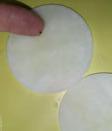
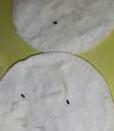
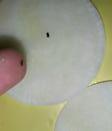
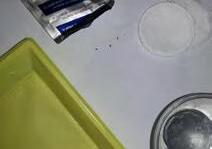
Lavender seeds are in a dormancy phase.

White-orange shaded radicles grow from lavender’s seeds coat.
Translucent white hypocotyl bloom out of the cotton pads and push the seeds upwards.
White-orange radicles are intertwined in the cotton pads. Hypocotyls’ length is about 2-3 cm. The small cotyledons are more visibile and green.

13
Date 09/11/2021 Tools Cotton
it
cotton
GROWING MATERIALS DAY 0-1 DORMANCY 09/11-10/11/2021
LAVENDER SEEDS Place some cotton pads on a plate Soak the cotton pads with water to make them damp Take one lavender seed at time and place
on a
pad Cover the plate and leave it in an appropriate space
DAY 4-5 GROWTH 13/11-14/11/2021
DAY 2-3 OPENING SEEDS 11/11-12/11/2021
DAY
GROWTH 15/11/2021
6
16/11/2021
DAY 7 GROWTH
Hypocotyls get longer and waved. Some radicles are visible above the cotton pads.



17/11/2021
DAY 8 TRANSPLANT
Coleoptiles are long 4-6 cm and are ready to be transplanted in cups with damp cotton wool.

18/11-22/11/2021
DAY 9-13 GROWTH
Lavender coleoptiles become longer. The black seeds coats fall off and first foliage leaves turn greener.
23/11-24/11/2021
DAY 14-15 GROWTH
Coleoptiles are long around 6 cm. The primary leaves are completely open.
GROWING MATERIALS
Lifecycle diagram
25/11/2021
DAY 16 DORMANCY
Lavender coleoptiles die for lack of watering. Their roots become orange and withered.
Other info
• TOTAL TIME OF MAINTENANCE: 16 days
• LIGHT: Indoor

• TEMPERATURE: Room temperature around 25-28 °C
• NUTRITION: None
• HUMIDITY: Through insing and draining
NOTES & IMPROVEMENTS
Lavender seeds died for improper watering and hot temperature in the room
NEED TO CONTROL BETTER THE SETTING
PERSONAL COMMENTS
Lavender seeds needs a lot of care and maintenance. Different trials have been made putting the seeds inside and on the top of the cotton pads and, unfortunately, some of the lavender seeds never bloomed out.
REFERENCE: LAVENDER SEEDS. Lavandula angustifolia facts by EdenBrothers
15
Dormancy Growth Wilting Afterlife Activation Withering Deactivation Transplanting DAY 0 DAY 16 DAY 2 DAY 8 DAY 15 Time and maintenance
SEEDS
LAVENDER
General info
BOTANICAL NAME:
GERMINATION:
LIFE CYCLE:
PLANTING PERIOD:
HARVEST PERIOD:
WATERING FREQUENCY:
SUITABLE FOR POTS:
SEEDS SHAPE:
SEEDS COLOR:
SEEDS DIMENSIONS:
LIGHT REQUIREMENT:
TEMPERATURE REQUIREMENT:
HUMIDITY REQUIREMENT:
DISTANCE REQUIREMENT:
USE:
lemon.
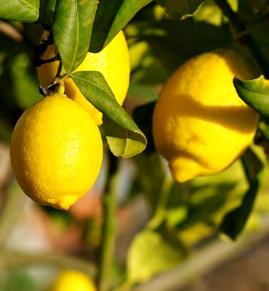
Citrus trifuliata
7-9 days
Perennial
February - june
July - December
1 time/day in summer, 1 time/week in winter
Yes
Drop-like
White/yellowish
LENGTH: 6-8 mm THICKNESS: 5-6 mm
Full sun
20-30 °C
Not specified
SPACING: n/s DEPTH: n/s
Fragrance, culinary, medicinal purposes
17 16
Oscar Tintori
trial n.2
Date 05/11/2021
Tools
Lemon Water
Hydrogen Peroxide Paper Towel Plate & Containers Knife Sealed Bag
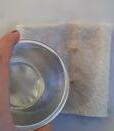
Preparation
Cut the lemon in half, squeeze it and remove the seeds under the pulp

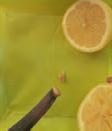
Place the seeds on a quarter of paper towel, leaving some space between them
Lifecycle
DAY 0-20
DORMANCY
Lemon seeds are still in dormancy. Their activation process is made by mixing hydrogen peroxide and water. The back of the seeds has a dark shade. The coat is still covered by a jell-like veil.
05/11-25/11/2021
Imbibit the paper towel with a dash of hydrogen peroxide
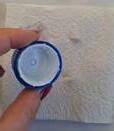
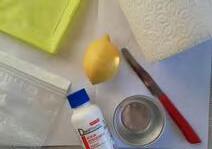
LEMON SEEDS


Imbibit the paper towel with a dash of water
Let the paper towel soak and put it in a sealed bag, labelling it with the date
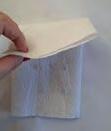
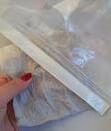
DAY 21-24
TRANSPLANT 26/11-29/11/2021
The lemon seeds seem to be in dormancy. As a second trial, they have been transplanted in another substrate, cotton wool.
DAY 25
OPENING SEEDS 30/11/2021
One of the seed’s coat is opening, therefore it has been moved in another paper cup.
DAY 26-39
OPENING SEEDS
The hatched lemon seed creates a larger opening to allow the green and white root to spring up. The seed’s coat becomes fragile and brownish.

01/12-14/12/2021

19
Fold the paper towel in four
GROWING MATERIALS
15/12-24/12/2021
DAY 40-50 GROWTH
The white tip is now long about 4-5 mm. The seed inside the coat becomes greener.

25/12/202112/01/2022
DAY 51-70 GROWTH
The seed grows and the epicotyl reaches a length of 10 cm. The radicle is about 2-3 cm.



13/01-15/01/2022
DAY 71-73 WITHERING
The seedling shows lack of proper nutriets and the radicle starts to wither.
Lifecycle
16/01-18/01/2022
DAY 74-76 DEACTIVATION
The lemon stops its growth and slowly becomes darker. In few hours it is totally shrinken, fragile and dies.
Other info
• TOTAL TIME OF MAINTENANCE: 76 days
• LIGHT: Indoor
• TEMPERATURE: Room temperature around 25-28 °C
• NUTRITION: None
• HUMIDITY: Through insing and draining
NOTES & IMPROVEMENTS
Lemon seeds died for improper nutrients
PERSONAL COMMENTS
This growing experimentation was the longest one, but it was extremely satisfying to see the seed’s coat opening and then growing so quickly.
REFERENCE: How to grow lemon tree by MyGardenChannel on Youtube
21
Dormancy Growth Wilting Afterlife Activation Withering Deactivation Transplanting DAY 0 DAY 76 DAY 25 DAY 21 DAY 71 Time and maintenance
diagram LEMON SEEDS GROWING MATERIALS
General info
BOTANICAL NAME:
GERMINATION:
LIFE CYCLE:
PLANTING PERIOD:
HARVEST PERIOD:
WATERING FREQUENCY:
SUITABLE FOR POTS:

SEEDS SHAPE:
SEEDS COLOR:
SEEDS DIMENSIONS:
LIGHT REQUIREMENT:
TEMPERATURE REQUIREMENT:
HUMIDITY REQUIREMENT:
DISTANCE REQUIREMENT:
USE:
catnip.
Nepeta cataria
7-10 days
Perennial
All seasons, best in spring
All seasons
1-2 times/day
Yes
Oval Black
LENGTH: 2-3 mm
Full sun
10-30 °C
Not specified
THICKNESS: 2 mm
SPACING: 50 mm DEPTH: 30 mm
Cat medicine, flavor teas
23 22
PetFamily
trial n.3
Date 04/11/2021
Tools
Catnip seeds
Water
Cotton Wool
Plate/Container Plastic wrap/Lid

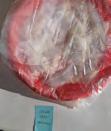
Preparation
Spread a layer of cotton wool over the bottom of a plate

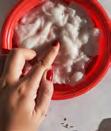

Imbibit the cotton wool with water until it is evenly damp

Pull the cotton wool apart to break up the fibers and eventually remove extra water


Lifecycle
Catnip seeds are activated by placing them on the cotton wool and soaking them with water.

Seeds’ coat start to open, allowing radicles to germinate above the cotton wool.
White radicles grow inside the cotton wool and coleoptiles bloom out of the seeds’ coat with a color gradient from dark red to white at the tip of the root
Primary leaves reach a length of 4,5-5 cm and are ready to be transplanted in paper cups.
Nestle the seeds into the top of the cotton wool leaving enough space between them
Cover the plate with plastic wrap , label it and place it in a proper location

25
DAY 0-2 DORMANCY 04/11-06/11/2021
DAY 4-6 GROWTH 08/11-10/11/2021
DAY 3 OPENING SEEDS 07/11/2021
DAY 7 TRANSPLANT
11/11/2021
GROWING
CATNIP SEEDS
MATERIALS
12/11-25/11/2021
DAY 8-21 GROWTH
Catnip leaves are 6-8 cm long. Some seeds are still in dormancy phase.
26/11-27/11/2021
DAY 22-23 GROWTH
The still-in-dormancy seeds start their growth process, opening and leaving the coleoptiles to grow.




28/11-29/11/2021
DAY 24-25 GROWTH
The green leaf is growing longer (around 9-10 cm). The small coleoptile on the left is showing its epicotyls. The other one is 2.5 cm long.
30/11/-04/12/2021
DAY 26-30 WILTING
One of the leaves is absolutely withered. The newer ones, on the other hand, grow green and strong.
05/12-06/12/2021
DAY 31-32 DEACTIVATION
The last two leaves are permanently withered due to the lack of nutrients and the improper temperature.

Other info
Afterlife
Dormancy Growth Wilting Time and maintenance
• TOTAL TIME OF MAINTENANCE: 32 days
• LIGHT: Indoor
• TEMPERATURE: Room temperature around 25-28 °C
• NUTRITION: None
• HUMIDITY: Through insing and draining
PERSONAL COMMENTS
REFERENCE: How to grow catnip by The Spuce
CATNIP SEEDS GROWING
27
Catnip was very easy to activate and grow but it would have been more interesting to sow more of them on the surface. Activation Withering Deactivation DAY 0 DAY 32 DAY 3 DAY 7 DAY 26
Transplanting
Lifecycle diagram
MATERIALS
trial n.4
Date 04/11/2021
Tools
Catnip seeds
Water Cotton pads




Plate/Container Plastic wrap/Lid
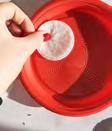
Lifecycle
Catnip seeds are activated by placing them on cotton pads and soaking them with water.

Preparation
Start putting the cotton pads over the bottom of a plate
Create a whole layer of cotton pads
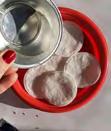

Remove extra water and leave it soak for a bit
Nestle the seeds into the centre of the cotton pads

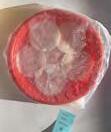
Cover the plate with plastic wrap, label it and place it in a proper location.
White radicles grow above the cotton pads and coleoptiles bloom out of the seeds’ coat with a color gradient from yellow to pink and white. They reach 1-3.5 cm.
Seeds’ coat start to open, allowing radicles to germinate above the cotton. DAY 7
Primary leaves reach a length of 4,55 cm and their radicles don’t have enough cotton for interwine and search nutrients.

29
Create a whole layer of cotton pads
DAY 0-2 DORMANCY 04/11-06/11/2021
DAY 4-6 GROWTH 08/11-10/11/2021
OPENING SEEDS 07/11/2021
DAY 3
TRANSPLANT
11/11/2021
GROWING MATERIALS
CATNIP SEEDS
12/11-17/11/2021
DAY 8-13 GROWTH
Catnip leaves are 6-8 cm long. Some seeds are still in dormancy phase. Epicotyls become visible and have a length of 1 to 2 cm.
18/11-19/11/2021
DAY 14-15 GROWTH
Epicotyls grow slowly and take a intense green shade.


20/11-27/11/2021
DAY 16-23 GROWTH
Some green epicotyls keep growing. Others grow but become shrunken and weak.



28/11-02/12/2021
Lifecycle diagram
03/12/2021
DAY 24-28 WILTING
Catnip leaves appear weak but still alive, therefore they have been trimmed.
Other info
• TOTAL TIME OF MAINTENANCE: 29 days
• LIGHT: Indoor
• TEMPERATURE: Room temperature around 25-28 °C
• NUTRITION: None
• HUMIDITY: Through insing and draining
PERSONAL COMMENTS
Catnip was very easy to be activated and grow but it would have been more interesting to sow more of them on the surface.
DAY 29 DEACTIVATION
The last withered leaf is definetely dead.
REFERENCE: How to grow catnip by The Spuce
31
Activation Withering Deactivation DAY 0 DAY 29 DAY 3 DAY 7 DAY 24 Time and maintenance
Dormancy Growth Wilting Afterlife
CATNIP SEEDS GROWING
Transplanting
MATERIALS
trial n.5
Date 04/11/2021
Tools
Catnip seeds 100 ml of water
1 g of Agar Powder Pot Spoon Container With lid Stove
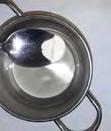
Preparation
Prepare 1% agar solution by dissolving 1 g of agar powder in 100 ml of water


Cook over a medium heat and stir until the solution starts to boil and becomes viscose

Cool the solution slightly and pour into a container
Lifecycle
DAY 0-3 DORMANCY 04/11-07/11/2021
Catnip seeds are activated by placing them on the agar solution.
DAY 4 OPENING SEEDS 08/11/2021
Seeds’ coat start to open, allowing radicles to bloom.
Place the seeds equidistantly on the surface of the agar


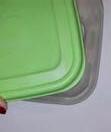
The thickness of the substrate should be twice the thickness of the seeds
Cover the container with its lid and place it in an appropriate location


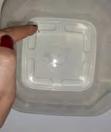
DAY 5 GROWTH 09/11/2021
White shaded radicles grow out of the seeds’ coat with 4 mm of length One small and shaded coleoptile starts to bloom vertically.
DAY 6-8 GROWTH 10/11-12/11/2021
One primary leaf sprouts and grows of 1 cm vertically. All the white roots penetrate inside the solution and new coleoptiles start to sprout.

33
GROWING MATERIALS
CATNIP SEEDS
14/11-17/11/2021
The longest leaf is 3 cm long. One of the two still-closed seeds shows white mold on its surface, that has been removed with a cutter

DAY 10-13 GROWTH
Green epicotyls emerge from the coleoptiles, with a length of 6-7 mm.
18/11-23/11/2021
DAY 14-19 GROWTH
Catnip epicotyls keep growing. Some orange spots and mold appear on the agar substrate and the seeds. Mold has been removed from the top of the seeds.
24/11-28/11/2021
DAY 20-24 WILTING
Some radicles come off the agar substrate, thus some catnips epicotyls become deactivated. The agar composite shrinks and can be unmold from the container.
29/11-30/11/2021
DAY 25-26 DEACTIVATION
Agar is completely dry and shrinken. Seedlings are totally withered. New seeds are in search of nutrients and water. This could be the right moment to let the agar compost in the soil.

CATNIP SEEDS
Growth Wilting

Dormancy Time and maintenance
Other info
• TOTAL TIME OF MAINTENANCE: 26 days
• LIGHT: Indoor
• TEMPERATURE: Room temperature around 25-28 °C
• NUTRITION: None
• HUMIDITY: Through insing and draining
NOTES & IMPROVEMENTS
Agar is an interesting substrate for seeds. However when it becomes completely dried, seedlings must be already planted somewhere.
PERSONAL COMMENTS
REFERENCE: Agar Germination Method by Cropgenebank


35
This technique was new to me but very interesting to combine bioplastic concept with growing materials as seeds. Afterlife Activation Withering Deactivation DAY 0 DAY 26 DAY 4 DAY 20
MATERIALS
Lifecycle diagram
GROWING
DAY 9 GROWTH
13/11/2021
trial n.6
Date 13/11/2021
Tools
Catnip seeds
Water
Knit Wool Samples
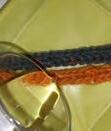



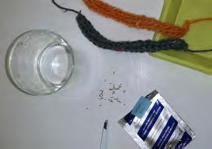

Plate/Container Plastic Wrap
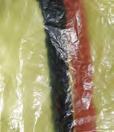
Tweezers
Preparation
Place one or more wool samples lying flat on the plate

Soak them with enough water to make them moist
Take one seed at a time and place it in the damp wool with tweezers

Lifecycle
DAY 0-3 DORMANCY
Catnip seeds are activated by placing them on knitted wool.
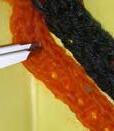
13/11-16/11/2021
DAY 4 OPENING SEEDS
Seeds’ coat start to open, allowing radicles to bloom.
17/11/2021
Go ahead leaving 1-2 cm spacing between seeds until all the surface is covered
Use some plastic wrap to cover the seeds and place it in a proper space
DAY 5-10 GROWTH
White shaded radicles grow out of the seeds’ coat. Coleoptiles sprout vertically and are long 0.5-4 cm. Their color gradient goes from white to pink.
DAY 11-12 GROWTH
Some leaves are strong and vertical. Others show a undulating silhouette and become darker.
17/11-22/11/2021
23/11-24/11/2021
37
SEEDS
CATNIP
GROWING MATERIALS
26/11-27/11/2021
DAY 13-14 GROWTH
Some of the withered catnips become stronger by watering them. One of the seedlings’ epicotyl is now visible. It is long 5 mm and its color grandient goes from white to light green.

28/11-29/11/2021
DAY15-16 GROWTH
The catnip seedlings keep growing and reach 4-5 cm of length.
30/11/-16/12/2021
Lifecycle diagram
17/12/-18/12/2021
DAY 17-34 WILTING
Catnip epicotyls keep growing. Some orange spots and mold appear on the agar substrate and the seeds. Mold has been removed from the top of the seeds.
DAY 35-36 DEACTIVATION
The last catnip is wilting and fall off on the wool surface. In few hours it dies.
• TOTAL TIME OF MAINTENANCE: 36 days
• LIGHT: Indoor
• TEMPERATURE: Room temperature around 25-28 °C
• NUTRITION: None
• HUMIDITY: Through insing and draining
NOTES & IMPROVEMENTS
Wool is perfect to let seeds grow. This test was a starting point for the thesis’ project.
PERSONAL COMMENTS
The process of wilting was slow and not linear. Knitting wool for this test was so soothful and stimulating.



39
Other info
REFERENCE: Seeds in knitted wool by Lara Campos for her project beGrounded
Dormancy Growth Wilting Afterlife Activation Withering Deactivation DAY 0 DAY 36 DAY 4 DAY 17 Time and maintenance
CATNIP SEEDS GROWING MATERIALS
General info
BOTANICAL NAME:
GERMINATION:
LIFE CYCLE:
PLANTING PERIOD:
HARVEST PERIOD:
WATERING FREQUENCY:
SUITABLE FOR POTS:
SEEDS SHAPE:
SEEDS COLOR:
SEEDS DIMENSIONS:
LIGHT REQUIREMENT:
TEMPERATURE REQUIREMENT:
HUMIDITY REQUIREMENT:
DISTANCE REQUIREMENT:
USE:
chia.
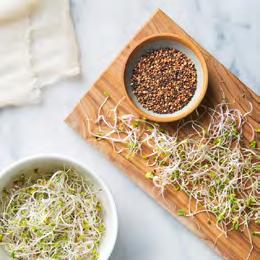
Salvia hispanica
3-14 days
Annual
All seasons, better spring
All seasons, better summer
2-3 times/day
Yes Oval
Dark brown, grey, creamy
LENGTH: 1-2 mm
Full sun
15-20 °C
Prefers dried soils
THICKNESS: 1.5-2 mm
SPACING: 15-20 cm DEPTH: 6 mm
Culinary, medicinal purposes, ornamental
41 40
Pickels & Honey
trial n.7
Date
13/11/2021
Tools
Hydrated chia seeds
100 ml of water 1 g of Agar Powder Pot Spoon Container With lid Stove
Preparation
Prepare 1% agar solution by dissolving 1 g of agar powder in the water


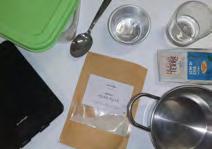
Cook over a medium heat and stir until the solution starts to boil and becomes viscose

Cool the solution slightly and pour into a container.
Lifecycle
DAY 0 DORMANCY
Some chia seeds are on the bottom and others are sticked to the surfaced, depending on their density and the reaction with the agar solution.

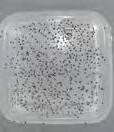
13/11/2021
The thickness of the substrate should be twice the thickness of the seeds

Pour hydrated chia seeds on the substrate. Some may fall on the bottom.
Cover the container with its lid and place it in an appropriate location

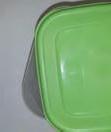
DAY 1 OPENING SEEDS
Some white small radicles start to bloom out of the coats. Those seeds settled on the bottom of the container seem to be in dormancy.
DAY 2 GROWTH
White radicles become longer (6-7 mm) and furry. Small and green coleoptiles bloom out out of the tip of the radicles.


DAY 3-8 GROWTH
Coleoptiles become white and longer (around 2-8 cm). At the tip of them some small and bright green foliages appear. Agar substrate has a sweet smell.
Seedlings are following the light and grow in the same direction.
14/11/2021
15/11/2021
16/11-21/11/2021
43
GROWING
CHIA SEEDS
MATERIALS
23/11-24/11/2021
DAY 10-11 GROWTH
Coleoptiles are long about 8-9 cm and follows the direction of the sunlight, giving them an extremely inclined shape. The chia seeds at the bottom of the agar solution become darker and browner.
25/11/2021
DAY 12 GROWTH
Brown halos grow at the bottom of the agar substrate. Chia primary leaves are completely open and have an intense green color.
26/11-28/11/2021
Lifecycle
29/11/2021
DAY 13-15 GROWTH
The radicles move inside the agar substrate to search for nutrients. Mold spots become darker. The agar sheet is dried enough to come off the mold. Its thickness is about 4 mm.
DAY 16 WILTING
As the sheet shrinks and dries out, on its bottom the seeds with brown halos emerge, open and let long and white radicles bloom out of the coats.
30/11-01/12/2021
DAY 17-18 DEACTIVATION
Agar shrinks and dries up. Seedlings are totally withered. New seeds are in search of nutrients and water.


The dead sample is dark, strong and inflexible.
• TOTAL TIME OF MAINTENANCE: 18 days
• LIGHT: Indoor
• TEMPERATURE: Room temperature around 25-28 °C
• NUTRITION: None
• HUMIDITY: Through insing and draining

NOTES & IMPROVEMENTS
The seeds on the bottom, starting to grow when the material is shrinking, show the possibility to integrate them in bioplastics.
PERSONAL COMMENTS
The process was extremely stimulating and fascinating since the seeds on the bottom showed to be still alive and to support my thesis idea.

REFERENCE: Agar Germination Method by Cropgenebank

45
info
Other
Dormancy Growth Wilting Afterlife Activation Withering Deactivation DAY 0 DAY 18 DAY 1 DAY 16 Time and maintenance
diagram GROWING MATERIALS
CHIA SEEDS
trial n.8
Date 13/11/2021
Tools
Hydrated chia seeds Water
Knit Wool Samples



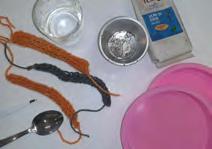

Plate/Container
Plastic Wrap
Tweezers
Preparation
Place the wool samples lying flat on the plate
Soak them with enough water to make them moist
Take some hydrated chia seeds and place them in the moist wool with tweezers
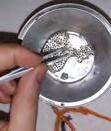


Lifecycle
DAY 0 DORMANCY 13/11/2021
Chia seeds are activated by placing them inside the wool and their white halos become bigger.

Go ahead, leaving some space between seeds until all the surface is covered
Use some plastic wrap to cover the seeds and place it in a proper space
DAY 1
OPENING SEEDS 14/11/2021
Seeds’ coat start to open, allowing white radicles to bloom.
DAY 2 GROWTH 15/11/2021
The small radicles grow out of the seeds’ coat with 3-4 mm of length and become hairy. Small and green coleoptiles bloom out of the tip of the radicles.

DAY 3-5 GROWTH
Coleoptiles become white and longer (around 2 cm). Small and intese green foliages leaves appear. White and translucent radicles are growing beyond the samples.
16/11-18/11/2021
47
MATERIALS
CHIA SEEDS GROWING
19/11/-23/11/2021
DAY 6-10 GROWTH
The dicotyledons show the small pair of green primary leaves. Then, the primary leaves completely open and take on a darker green color.
The coleoptiles are long 8 cm and get tangled up by following the sunlight.
24/11-26/11/2021
DAY 11-13 GROWTH
The roots move in search of nutrients and are characterized by a white-orange gradient.


Some seedlings are entirely dried, becoming shrunken and withered.
27/11-29/11/2021
Lifecycle diagram
30/11-05/12/2021
DAY 14-16 WILTING
Chia seedlings appear increasingly weak and fall off on the sides.

Those already dead and withered have reduced their diameter (that is about 0.1 mm), are very shriveled and dark.

DAY 17-22 WILTING
The living leaves are strong and their coleoptiles are thicker. The roots of the dead seedlings are brownish at the bottom of the wool samples.
06/12-07/12/2021
Other info
• TOTAL TIME OF MAINTENANCE: 24 days
• LIGHT: Indoor
• TEMPERATURE: Room temperature around 25-28 °C
• NUTRITION: None
• HUMIDITY: Through insing and draining
NOTES & IMPROVEMENTS
This test on knitted wool worked better than that of catnip seeds.
DAY 23-24 DEACTIVATION
The last coleoptiles are weak and withered.
The wool sample is completely dry and shows thin and dark seedlings. On its back the radicles are wrinkled and brown.

PERSONAL COMMENTS
The process of wilting was slow. Knitting wool for this test was funny and stimulating. The effect of chia seeds on wool was so lovely!
REFERENCE: Seeds in knitted wool by Lara Campos for her project beGrounded
49
Dormancy Growth Wilting Afterlife Activation Withering Deactivation DAY 0 DAY 24 DAY 1 DAY 14 Time and maintenance
CHIA SEEDS
GROWING MATERIALS
GROWING MATERIALS
trial n.9
Date 26/11/2021
Tools
Hydrated chia seeds Water
2 Cotton Fabric Samples (10X10 cm)
Two Plates Tweezers
Preparation
Cut two samples of cotton and place the first one on a plate to soak it with water
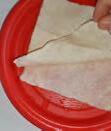



Place the second sample on the first one

Soak the samples with enough water
Lifecycle
DAY 0 DORMANCY

Chia seeds are activated by placing them on the cotton samples and their jelly halos become bigger.
26/11/2021
DAY 1 OPENING SEEDS
White small radicles bloom out of the coats to anchor the seedlings.
27/11/2021
DAY 2 GROWTH 28/11/2021
White radicles become more long and curly, searching for nutrients.

DAY 3-4 GROWTH
Coleoptiles grow a little. White and translucent radicles are growing on the samples.

29/11-30/11/2021
Place hydrated chia seeds, helping you with tweezers
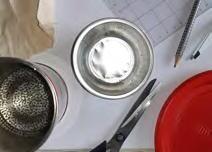
CHIA SEEDS
Go onplacing the chia seeds until the surface is covered (around 20-25)
Cover the plate with another plate and place it in an appropriate location
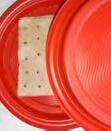
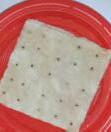
51
01/12-02/12/2021
DAY 5-6 GROWTH
Few dicotyleons are growing, making visible embryonic leaves. The radicles struggle to find stability and collect nutrients. Some seeds are still in dormancy.
03/12-04/12/2021
DAY 7-8 WILTING
The seedlings are still growing but they are laying on the cotton fabric and looks darker. Some coleoptiles are almost dead and come off the surface easily.



05/12-07/12/2021
Lifecycle diagram
08/12/2021
DAY 9-11 WILTING
The long seelings keep growing stronger.
Some of the seeds show small foliages opening inside the coat even though their radicles are very short.

DAY 12 DEACTIVATION
The radicles cannot reach more nutrients without going under the fabric. They rapidly shrink and die.
Other info
• TOTAL TIME OF MAINTENANCE: 12 days
• LIGHT: Indoor
• TEMPERATURE: Room temperature around 25-28 °C
• NUTRITION: None
• HUMIDITY: Through insing and draining
NOTES & IMPROVEMENTS
Comparing this growing test with test n.#12 of chia seeds on paper towel, it can be assumed that the cotton fabric make the process slower.
PERSONAL COMMENTS
Chia seeds struggled to be alive and it was hard to save them.
53
Dormancy Growth Wilting Afterlife Activation Withering Deactivation DAY 0 DAY 12 DAY 1 DAY 7 Time and maintenance
CHIA SEEDS GROWING
MATERIALS
trial n.10
Date 26/11/2021
Tools
Hydrated chia seeds
Water
Wool felt sample (10X10 cm)
Two Plates Tweezers
Preparation
Cut the samples of wool felt and place the first it on a plate

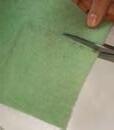

Soak the sample with water until it is damp
Place hydrated chia seeds, helping you with tweezers

Lifecycle
DAY 0 DORMANCY
Chia seeds are activated by placing them on the woollen felt and their white halos become bigger.
26/11/2021
DAY 1 OPENING SEEDS
White small radicles bloom out of the coats to anchor the seedlings into the wool. Some watering is needed.
27/11/2021
Go on placing the chia seeds until the surface is covered (around 20-25)
CHIA SEEDS
Cover the plate with another plate and place it in an appropriate location
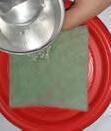
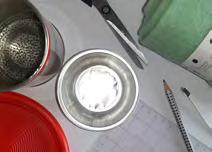

DAY 2-3 GROWTH
The radicles grow out of the seeds’ coat with 1-2 cm of length, going inside the wool.


Coleoptiles bloom out and push upwards their pale green tips.
DAY 4 GROWTH
Coleoptiles become white and longer (around 2 cm). Small and intese green foliages leaves appear. White and translucent radicles are growing inside the wool sample.

28/11-29/11/2021
30/11/2021
55
GROWING MATERIALS
01/12-02/12/2021
DAY 5-6 GROWTH
Coleoptiles follow the sunlight direction. The first two leaves are open and green. Some seeds are still in dormancy or opening.
03/12-05/12/2021
DAY 7-9 GROWTH
Chia seedlings are in lack of water because of the high indoor temperature. They fall off on the woollen surface but they are still alive. The chia seedlings keep growing stronger and their leaves turn darker.
Other info
06/12-09/12/2021
DAY 10-13 WILTING
The foliage is growing stronger. Two of the seedlings are weak and withered, turning very thin and brown. Some seeds are just opening and blooming directly as primary leaves.
10/12-11/12/2021
DAY 14-15 WILTING
Some of the coleoptiles become weak and fall off the woollen surface. The seedlings need more watering and nutrients.





12/12-13/12/2021
DAY 16-17 DEACTIVATION
The felt dries up quickly and the seedlings fall off on the surface. The next day the seedlings die definitively in need of nutrients besides water.
• TOTAL TIME OF MAINTENANCE: 17 days
• LIGHT: Indoor
• TEMPERATURE: Room temperature around 25-28 °C
• NUTRITION: None
• HUMIDITY: Through insing and draining
NOTES & IMPROVEMENTS
Comparing this growing test with tests n.#9 and n.#12, it can be inferred that the wool fabric allows a slower process than paper towel but quicker than the cotton one.
PERSONAL COMMENTS
Chia seeds are the quickest seeds tested and they show to grow easily on wool surfaces. This is a good news for the fashion system!
57
REFERENCE: Seeds in wool felt by Paula Ulargui Escalona
Dormancy Growth Wilting Afterlife Activation Withering Deactivation DAY 0 DAY 17 DAY 1 DAY 10 Time and maintenance
Lifecycle diagram
GROWING MATERIALS
CHIA SEEDS
trial n.11
Date 11/03/2022
Tools Hydrated chia seeds Water Wool felt sample (10X10 cm) Two Plates Tweezers

Preparation
Place the wool felt sample on a plate or container
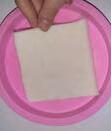
Soak the sample with water until it is damp
Pour a good quantity of chia seeds on the surface with the help of tweezers
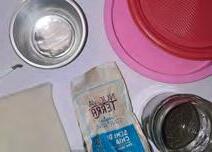

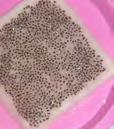
Lifecycle
Cover the entire surface with chia seeds, using the tweezers
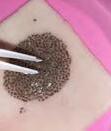
CHIA SEEDS
Make the seeds surface even in order to make them grow easily

Cover the plate with another plate and place it in an appropriate location
DAY 0
DORMANCY 11/03/2022

Chia seeds are activated by placing them on the woollen felt and their white halos become bigger.


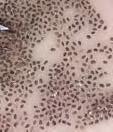
DAY 1
OPENING SEEDS
White small radicles bloom out of the coats to anchor the seedlings.
12/03/2022
DAY 2 GROWTH 13/03/2022
White radicles become longer (6-7 mm) and furry.
DAY 3 GROWTH
The radicles grow out of the seeds’ coat with 3-4 cm of length. They can’t penetrate in the paper so they grow on the surface.
Coleoptiles bloom out and push upwards their pale green tips.
14/03/2022
59
GROWING MATERIALS
15/03-18/03/2022
DAY 4-7 GROWTH
Coleoptiles follow the sunlight direction. The first two leaves are open and green. Some seeds are still in dormancy or opening.
19/03-20/03/2022
DAY 8-9 GROWTH
Chia seedlings are in lack of water because of the high indoor temperature. They fall off on the woollen surface but they are still alive. The chia seedlings keep growing stronger and their leaves turn darker.
Other info
21/03/-22/03/2022
DAY 10-11 GROWTH
The foliage is growing stronger. Two of the seedlings are weak and withered, turning very thin and brown. Some seeds are just opening and blooming directly as primary leaves.
23/03/-26/03/2022
DAY 12-15 WILTING
Some of the coleoptiles become weak and fall off the woollen surface. The seedlings need more watering and nutrients.




27/03/-28/03/2022
DAY 16-17 DEACTIVATION
The felt dries up quickly and the seedlings fall off on the surface. The next day the seedlings die definitively in need of nutrients besides water.

• TOTAL TIME OF MAINTENANCE: 17 days
• LIGHT: Indoor
• TEMPERATURE: Room temperature around 25-28 °C
• NUTRITION: None
• HUMIDITY: Through insing and draining
NOTES & IMPROVEMENTS
This test showed the feasibility of combining wool felt with chia seeds. In particular, it is visible how the quantity of chia seeds can change the final effect of the sample,
PERSONAL COMMENTS
This sample is the one used to simulate the final prototype an undestand the timing. I love the contrast between green plants and white felt!
61
REFERENCE: Seeds in wool felt by Paula Ulargui Escalona
Dormancy
Afterlife Activation Withering Deactivation DAY 0 DAY 17 DAY 1 DAY 12 Time and maintenance
Growth Wilting
Lifecycle diagram CHIA SEEDS GROWING MATERIALS
trial n.12
Date 26/11/2021
Tools
Hydrated chia seeds Water Paper towel Two Plates Tweezers
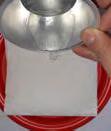
Lifecycle
DAY 0 DORMANCY 26/11/2021

Chia seeds are activated by placing them on the paper towel and their white halos become bigger.


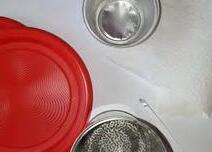

Preparation
Place hydrated chia seeds, helping you with tweezers
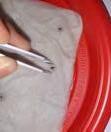
CHIA SEEDS
Go on placing the chia seeds until the surface is covered (around 20-25)
Cover the plate with another plate and place it in an appropriate location
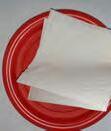
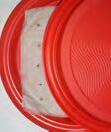
DAY 1 OPENING SEEDS
White small radicles bloom out of the coats to anchor the seedlings.
27/11/2021
DAY 2 GROWTH 28/11/2021
White radicles become longer (6-7 mm) and furry.

DAY 3 GROWTH
The radicles grow out of the seeds’ coat with 3-4 cm of length. They can’t penetrate in the paper so they grow on the surface. Coleoptiles bloom out and push upwards their pale green tips.
29/11/2021

63
Fold two veil of paper towel in fou Place it on the centre of a plate Soak the paper towel with some water
GROWING MATERIALS
30/11/2021
DAY 4 GROWTH
Coleoptiles become white and longer (around 4-5 cm). Small and intese green foliages leaves appear. White and translucent radicles are growing of 5-6 cm on the paper surface, in search of nutrients.


01/12/2021
DAY 5 GROWTH
Radicles become brownish. The coleoptiles are translucent and at their tip small foliages are opening.
02/12-05/12/2021
Lifecycle diagram
06/12/2021
The paper towel dries quickly. The radicles turn brown, therefore the seedlings look slightly withered, but still alive.


DAY 10 DEACTIVATION
The seedlings keep to dry out despite being watered day by day. This is to say that the nutrients are not enough against the high temperature of the indoor environment.
Other info
• TOTAL TIME OF MAINTENANCE: 10 days
• LIGHT: Indoor
• TEMPERATURE: Room temperature around 25-28 °C
• NUTRITION: None
• HUMIDITY: Through insing and draining
NOTES & IMPROVEMENTS
Comparing this growing test with tests n.#9 and n.#10, it is clear that paper towel could be an interesting substrate just for few hours.
PERSONAL COMMENTS
Chia seeds struggled to keep growing. The deactivation of seeds was expactable.
65
DAY 6-9 WILTING
Dormancy Growth Wilting Afterlife Activation Withering Deactivation DAY 0 DAY 10 DAY 1 DAY 6 Time and maintenance
CHIA SEEDS
MATERIALS
GROWING
trial n.13
Date 30/11/2021
Tools

Hydrated Chia Seeds
Water Cotton Tubular Yarn Plate Syringe

Thick Needle Tweezers Plastic Wrap
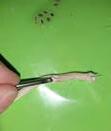
Preparation
Pick some hydrated chia seeds with the help of the tweezers
Make a hole (3 mm) inside the cotton yarn, piercing it with the tip of the needle

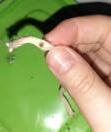
Put the chia seed inside the hole by helping you with the tweezers
Lifecycle
DAY 0-X DORMANCY 30/11-10/12/2021
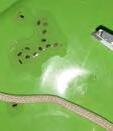
Chia seeds are placed inside the cotton yarn, but the test went wrong.
Lifecycle diagram
Try to draw together and close the cotton threads to encapsulate the seed
CHIA SEEDS
Soak the yarn, expecially on the seeds’ areas, by using a syringe
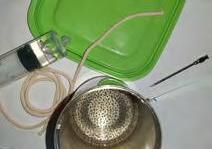
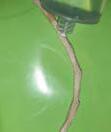
Cover the plate with some plastic wrap and place it in an appropriate location
NOTES & IMPROVEMENTS
The chia seeds are probably dead because of the pressure put on them during the process. Additionally, the yarn is very tight and difficult to make it wet.
NEED TO WORK MORE ON THIS
REFERENCE: Seeds in cotton yarn by Svenja Keune for her project On Textile Working
67
GROWING MATERIALS
Growth Wilting Afterlife Activation Withering Deactivation DAY 0 Time and maintenance
Dormancy
trial n.14
Date
10/12/2021
Tools
Hydrated Chia Seeds
Water Cotton Tubular Band Plate
Syringe
Wooden stick
Tweezers
Plastic Wrap
Preparation
Pick some hydrated chia seeds with the help of the tweezers
Put chia seeds inside the cotton band with the tip of the tweezers
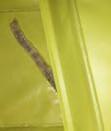
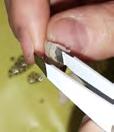


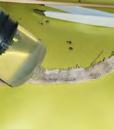

Put some pressure on the seeds to fill the cotton tube
Use the wooden stick to push chia seeds easily and go on filling all the length
CHIA SEEDS
Use the wooden stick to push chia seeds easily and go on filling all the length of the cotton band
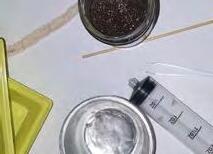
Cover the plate with another plate and place it in an appropriate location
DORMANCY
The chia seeds are activated inside the tubular cotton band. They are damp and their dark color is visible under the fabric.
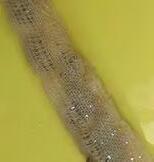


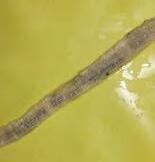
10/12/2021
OPENING SEEDS
The band is still damp and looks inflated because of the seeds halos.
11/12/2021
12/12/2021
Some of the chia seeds are opening and the radicles bloom out. One of the seeds comes out the cotton band, making it more visible.
DAY 3 GROWTH
The cotton fabric make it difficult to understand the stages of the seeds. Some of them seem to be still in activation while some others show small openings on their coats.
13/12/2021
69
GROWING MATERIALS
13/12/2021
DAY 3 GROWTH
The cotton fabric make it difficult to understand the stages of the seeds. Some of them seem to be still in activation while some others show small openings on their coats.
14/12-15/12/2021
DAY 4-5 GROWTH
The chia seeds that are outsided the cotton band can grow easily. Those that are inside do not have enough space to reach water and settle down.
Lifecycle diagram
16/12/2021
DAY 6 DEACTIVATION
The chia seeds seem to be deactivated since they do not show radicles. For those seedlings outside the band there’s need of water and they die quickly without a substrate.

Other info
• TOTAL TIME OF MAINTENANCE: 6 days
• LIGHT: Indoor
• TEMPERATURE: Room temperature around 25-28 °C
• NUTRITION: None
• HUMIDITY: Through insing and draining
NOTES & IMPROVEMENTS
The chia seeds are probably dead because the cotton fabric is not suitable for the growth.


NEED TO FIND NEW COTTON SOLUTIONS
PERSONAL COMMENTS
Even though the space was very neat, few chia seeds made it!
71
REFERENCE: Seeds in cotton yarn by Svenja Keune for her project On Textile Working
Growth Wilting Afterlife Activation Withering Deactivation DAY 0 DAY 6 DAY 1 Time and maintenance
Dormancy
GROWING MATERIALS
CHIA SEEDS
General info
BOTANICAL NAME:
GERMINATION:
LIFE CYCLE:
PLANTING PERIOD:
HARVEST PERIOD:
WATERING FREQUENCY:
SUITABLE FOR POTS:
SEEDS SHAPE:
SEEDS COLOR:
SEEDS DIMENSIONS:
LIGHT REQUIREMENT:
TEMPERATURE REQUIREMENT:
HUMIDITY REQUIREMENT:
DISTANCE REQUIREMENT:
USE:
sunflower.
Helianthus annuus

10-14 days
Annual
March - june
June - september
1 time/day
Yes
Drop-like
Dark brown/gray wiht white stripes
LENGTH: 6-7 mm THICKNESS: 2-3 mm
Full sun
15-20 °C
Prefers draining soils
SPACING: 20-30 cm DEPTH: 12 cm
Culinary, medicinal purposes, ornamental
73 72
Marina Reich - Unsplash
trial n.15
Date 03/12/2021
Tools
Hydrated sunflower seeds 100 ml of water



1 g of Agar Powder Pot Spoon Container With lid Stove
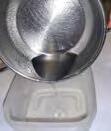
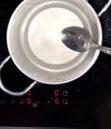
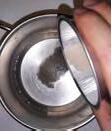
Preparation
Prepare 1% agar solution by dissolving 1 g of agar powder in the water


Cook over a medium heat and stir until the solution starts to boil and becomes viscose
Cool the solution slightly and pour into a container
Lifecycle
DAY 0
Once the solution seems to be jelly, pour the seeds on the top of it
The thickness of the substrate should be twice the thickness of the seeds
Cover the container with its lid and place it in an appropriate location
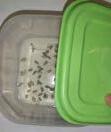
DAY 1
Sunflower seeds are activated by placing them on the agar solution. DAY 2
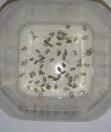
The seeds tips elongate to become radicles. The seeds are still movable on the agar substrate. They look more white and big. DAY 3
The radicles are white and furry and about 5-10 mm. Since the seeds are movable, some starts to penetrate into the agar substrate in search of nutrients and water. The opened parts of the seeds turn pale green.

The radicles grow with a length of 1-3 cm and are visibly different from the coleoptiles.
All the seedlings become intesely green and try to settle vertically.
75
DORMANCY 03/12/2021
GROWTH 05/12/2021
OPENING SEEDS 04/12/2021
GROWTH 06/12/2021
GROWING
SUNFLOWER SEEDS
MATERIALS
07/12-09/12/2021
DAY 4-6 GROWTH
The green of the seedlings become intense and darker in some spots. The roots turn into several radicles in search of nutrients and entagle with the others. Those sunflowers that are deep-rooted are growing vertically.
10/12/-11/12/2021
DAY 7-8 GROWTH
The sunflower seedlings grow stronger and greener. One of them reach the length of 8.5-9 cm.

Some radicles in the center of the agar substrate finally penetrate it and reach the bottom.
Other info
12/12/-13/12/2021
DAY 9-10 GROWTH
The agar is completely detachable from the container. This could be the right moment to transplant the substrate in a potting or garden soil.
The seedlings are growing and their radicles are extremely tangled up.


14/12/-18/12/2021
DAY 11-15 WILTING
The sunflower seedlings looks withered and in need of water. The agar substrate shrinks more and more, showing the radicles at its bottom.
19/12/2021
DAY 16 DEACTIVATION
The sunflower seedlings are withered. The agar substrate is totally shrinken and let the seedlings in lack of water.

• TOTAL TIME OF MAINTENANCE: 16 days
• LIGHT: Indoor
• TEMPERATURE: Room temperature around 25-28 °C
• NUTRITION: None
• HUMIDITY: Through insing and draining
NOTES & IMPROVEMENTS
The process showed once again the effectiveness of using agar as substrate for seeds.
PERSONAL COMMENTS
The process was satisfying to follow since the sunflower seedlings are bigger compared to the ones before.
REFERENCE: Agar Germination Method by Cropgenebank

77
Dormancy Growth Wilting Afterlife Activation Withering Deactivation DAY 0 DAY 16 DAY 1 DAY 11 Time and maintenance
MATERIALS
Lifecycle diagram GROWING
SUNFLOWER SEEDS
trial n.16
Date 26/11/2021
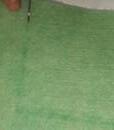
Tools
Hydrated sunflower seeds
Water
Wool felt sample (10X10 cm)
Two Plates
Pen Scissors
Preparation
Cut the samples of wool felt and place the first it on a plate


Soak the sample with water until it is damp
Place hydrated chia seeds, helping you with tweezers
Lifecycle
Sunflower seeds are activated by placing them on the woollen surface. Some of them are already open.




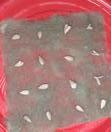
The seed tip begins to lengthen to become a radicle. The seeds are still movable on the felt surface.
The radicles are white, furry and long 3-5 mm. Some begin to settle into the holes in the wool.
Go on placing the sunflower seeds until the surface is covered (around 9-16)

Cover the plate with another plate and place it in an appropriate location
The radicles grow with a length between 4 and 25 mm and become less furry. The coleoptiles are now visibile and can be distinguished from the radicles. All the seedlings take on a pale green shade.
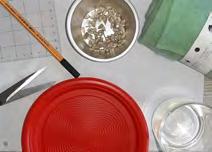
79
DAY 0 DORMANCY 03/12/2021
DAY 2 GROWTH 05/12/2021
DAY 1 OPENING SEEDS 04/12/2021
3
06/12/2021
DAY
GROWTH
GROWING MATERIALS
SUNFLOWER SEEDS
07/12-08/12/2021
DAY 4-5 GROWTH
Two of the sunflower seedlings are growing stronger. Their radicles multiply to reach more water and nutrients.


09/12-10/12/2021
DAY 6-7 GROWTH
One of the last two sunflowers is weak and start to fall off on the sides. The coleoptile of the other seedling takes a shade of pink and becomes longer. It is visible a transparent patina, that breaks off from the primary leaves.
11/12-15/12/2021
Lifecycle diagram
16/12/2021
DAY 8-12 WILTING
The last sunflower is withering because of the lack of water. The radicles become brownish and the foliage fall off on the surface. The felt has been watered again and the seedling recovers and gets up, but it still looks weak.
DAY 13 WILTING

The coleoptile is totally shrunken and withered. It losts its strength and dies.
Other info
• TOTAL TIME OF MAINTENANCE: 13 days
• LIGHT: Indoor
• TEMPERATURE: Room temperature around 25-28 °C
• NUTRITION: None
• HUMIDITY: Through insing and draining
NOTES & IMPROVEMENTS
Wool felt is tightly woven, thus the growth of sunflower seeds is quite difficult since they are bigger than chia seeds.
PERSONAL COMMENTS
Sunflower seeds create a stronger aesthetical effect compared to the other ones.
REFERENCE: Seeds in wool felt by Paula Ulargui Escalona

81
Dormancy Growth Wilting Afterlife Activation Withering Deactivation DAY 0 DAY 13 DAY 1 DAY 8 Time and maintenance
SEEDS GROWING
SUNFLOWER
MATERIALS
thank you.
NICLA GUARINO
 EDITED BY NICLA GUARINO
EDITED BY NICLA GUARINO

































































































































































































































































